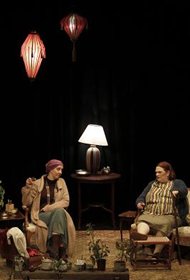Co-founded by Gibbons and Gregg in 2001, Electric Bridget has, since its inception, aimed to entertain through darkly comic means. Penned by Gibbons, The Grippe Girls signifies precisely the company’s fundamental aspirations. This two-hander stitches together the bawdy and unsavoury stories of the ancient Grippe twins Hildegarde (Gregg) and Obstina (Gibbons), who embody the diminishing remnants of a once great Anglo-Irish family. The advent of a “woman-journalist”, who wishes to record an interview with the sisters, provides a realistic forum for the characters to communicate their lively (or deadly) tales directly to the audience.
Attending Hildegrade and Obstina is another, equally ancient set of twins, Margaret and Brigid, also played by Gregg and Gibbons respectively. These loyal and protective servants quite literally keep the show on the road, humorously maintaining the pretence of the household’s former etiquette and activity. Preserving the family’s good name appears to be the goal of these flustered, moralising Catholics, their tight-lipped prudence offering a comic foil to the outspoken Grippes. Using only aprons to differentiate between the two characters they each play, Gregg and Gibbons showcase their skills, rapidly switching between plausible roles. Hildegarde and Obstina’s costumes are plainer and less aristocratic than those used in the press shot, but well-chosen for their versatility.
 Gavin Morgan’s set conjures an image of a once opulent, but now gaudy, drawing room cluttered with fragments of its former glory: crystal vessels, a large oriental rug, withered tomato plants and wildlife magazines. While conveying an appropriate sense of decaying grandeur, the design was perhaps too detailed for such a small venue. From where I sat, a couple of rows from the stage, it was difficult to get a clear panorama of the set’s intricacy; the layout of the six or so rows of un-tiered folding seats impeded the view. In addition, their noisiness as a result of any shifting or movement can be distracting.
Gavin Morgan’s set conjures an image of a once opulent, but now gaudy, drawing room cluttered with fragments of its former glory: crystal vessels, a large oriental rug, withered tomato plants and wildlife magazines. While conveying an appropriate sense of decaying grandeur, the design was perhaps too detailed for such a small venue. From where I sat, a couple of rows from the stage, it was difficult to get a clear panorama of the set’s intricacy; the layout of the six or so rows of un-tiered folding seats impeded the view. In addition, their noisiness as a result of any shifting or movement can be distracting.
Credible engagements between characters, the way in which Obstina absentmindedly mutters and trails off, as well as the perfectly timed delivery of shockingly funny punch-lines are among the highlights of McCloskey’s directorial debut. Margaret and Brigid’s apparent paranoia about visitors such as the journalist “asking too many questions” becomes understandable as secrets are inadvertently revealed. And, as the drama unfolds, the apparently vast differences between the two sets of twins diminishes and are exposed as superficial, making an oblique comment on class distinctions. To begin with, the comedy of the piece is rather silly, predictably caricaturing two Irish classes of a bygone era. However, it builds to a progressively darker – and progressively funnier – climax.
The Grippe Girls does not promote an emotional response or stimulate much philosophical enquiry; nonetheless, it offers a very enjoyable evening. Stripped of their humour, these figures would fit comfortably in a horror film. Although we never see or hear her, it is easier to sympathise with the journalist. The outrageous truths that lurk behind so many amicably told stories prevent us from relating to the characters, blocking the drama’s potential for poignancy. Yet, these untold mysteries place audience members in very fulfilling detective roles. They are crucial to the play’s capacity to entertain, as well as its black comedy.
Siobhán O’Gorman is currently completing a doctoral research project on gender and the canon in contemporary theatre at the National University of Ireland, Galway.